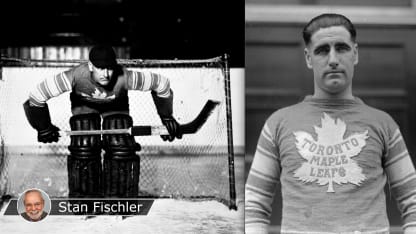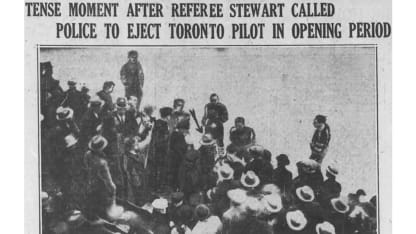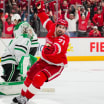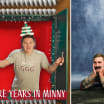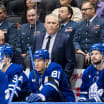For the first 15 seasons in the NHL, rules stipulated that if a goalie received a minor penalty, he had to serve it in the penalty box for the full two minutes.
But on the night of March 15, 1932, a raucous game between the Toronto Maple Leafs and Boston Bruins at Boston Garden would help change that rule and enable a goalie's penalty to be served by a teammate.
The rule turnabout was rooted in a rather innocent skirmish in the first period in front of the Maple Leafs' crease. Bruins forward Cooney Weiland had fallen to the ice near goalie Lorne Chabot. As Weiland lifted himself back into position, Chabot delivered a friendly love tap to Cooney's skate that sent the forward sprawling.
Referee Bill Stewart whistled Chabot for a two-minute tripping penalty. It marked the first time a goalie had to sit out his infraction in Boston.
Toronto coach Dick Irvin selected tough defenseman Red Horner to replace the penalized Chabot. Minus any goalie equipment -- including Chabot's gloves -- Horner skated to the crease.
Horner's first test was a hard drive by Weiland which was stopped by Horner, who made a deft kick save. But on the very next Boston counterattack, Marty Barry powered one past the Horner's flailing stick. Dismayed but not disheartened, Irvin yanked Horner and replaced him with another defenseman Alex "Kingfish" Levinsky.
"The Kingfish lasted only a dozen seconds," said Bruins historian Jeff Miclash, author of "Total Bruins, 1929-1939." "Barry got himself another power-play goal by beating Levinsky with a point shot and Irvin gave his second 'goalie' the hook."
In went another Maple Leaf defenseman, Frank "King" Clancy. He made several saves and then Stewart whistled play to a stop and handed out coincidental minors.
"This gave the Bruins a 4-on-3 advantage," Miclash explained. "The free ice allowed Eddie Shore to skate unopposed to the Leafs corner where he fed a short pass to George Owen who zipped a high shot over Clancy's shoulder."
In the unofficial NHL history, "The Trail of the Stanley Cup, Volume 2," author Charles L. Coleman described the game as "an extraordinary contest." As for the Maple Leafs reaction to Boston's three goals against four goalies in two minutes, Coleman added, "Needless to say, all this performance caused (Toronto) manager Conn Smythe to blow his top. As referee Stewart skated by the Leaf bench Smythe reached out and grabbed him by the sweater. The referee ordered Smythe from the bench but he refused to leave.
"Attendants were called and attempted to give the Toronto manager the well-known bum's rush. Some of the Toronto players intervened and punches were thrown."
A Boston Globe photographer recorded the scene with a caption as follows:
TENSE MOMENT AFTER REFEREE STEWART CALLED POLICE TO EJECT TORONTO PILOT IN OPENING PERIOD.
